2008 FIAT SEDICI wheel
[x] Cancel search: wheelPage 160 of 266

159
IMPORTANT
❒Never use the “4WD LOCK” mode
when driving on dry paved roads.
Avoid using the “4WD LOCK” mode
when driving on wet paved roads as
much as possible. Use of the “4WD
LOCK” mode in above conditions will
apply excessive force to the driving
system and may cause a critical failure.
Also, the tires may wear faster and fu-
el consumption may be affected ad-
versely.
❒Note that 4WD vehicles are not al-
laround vehicles. Be sure to observe
following instructions when driving
your vehicle.
– Do not drive through water like
crossing a river.
– Do not drive continuously where
front wheels tend to race such as in
the sand and mud.
– When any wheel is in the air for such
reason as running off the road, do
not race it needlessly.
❒If the “4WD AUTO” and the “4WD
LOCK” indicator lights stay on and
come on simultaneously when driving,
there may be something wrong the
4WD system. Have the system in-
spected by an authorized Fiat Dealer-
ship.IMPORTANT Unevenly worn tires can
cause problems in the operation of the
2WD/4WD switch. Be sure to rotate the
tires according to the maintenance sched-
ule. Refer to “Tires” and “Maintenance
Schedule” in the “INSPECTION AND
MAINTENANCE” section for proper tire
rotation procedures.
❒While making turns or accelerating and
decelerating, operating the 2WD/
4WD switch or turning off the key
switch in the “4WD AUTO” or “4WD
LOCK” mode may cause a shock, but
this is not a system malfunction.
❒While driving in the “4WD LOCK”
mode, as the vehicle speed increases,
the driving mode changes to the “4WD
AUTO” mode automatically. Even
when the vehicle speed reduces, on the
other hand, the driving mode does not
return to the “4WD LOCK” mode au-
tomatically. You should press the
“4WD LOCK” switch according to the
driving conditions.
❒Any forcible operation while driving of-
froad in the sand or water or when a
wheel has run off the road, the differ-
ence of the revolution between front
wheels and rear wheels increases
(wheels run idle). If this state continues,
the oil temperature of the driving sys-
tem parts rises.
In such case, the “4WD AUTO” indi-
cator light blinks and the driving mode
changes to the 2WD mode to protect
the driving system parts.
When you operate your vehicle in the
4WD mode continuously, park the ve-
hicle at a safe place and run the engine
idle. After some time, the “4WD AU-
TO” indicator light turns on again and
the driving mode returns to the “4WD
AUTO” mode.
149-166 Fiat16 New GB 3-09-2008 8:15 Pagina 159
Page 161 of 266

160
POWER ASSISTED BRAKES
Your vehicle has power assisted brakes. If
power assistance is lost due to a stalled
engine or other failures, the system is still
fully operational on reserve power and
you can bring the vehicle to a complete
stop by pressing the brake pedal once and
holding it down. The reserve power is
partly used up when you depress the
brake pedal and reduces each time the
pedal is pressed. Apply smooth and even
pressure to the pedal. Do not pump the
pedal.ANTI-LOCK BRAKE SYSTEM
(ABS) (if equipped)
ABS will help you avoid skidding by elec-
tronically controlling braking pressure. It
will also help you maintain steering con-
trol when braking on slippery surfaces or
when braking hard.
The ABS works automatically, so you do
not need any special braking technique.
Just push the brake pedal down without
pumping. The ABS will operate whenev-
er it senses that the wheels are locking up.
You may feel the brake pedal moves a lit-
tle while the ABS is operating.
NOTE The ABS will not work if vehicle
speed is under about 6 km/h (4 mph).
BRAKING
The distance needed to bring any vehicle
to a halt increases with the speed of the
vehicle. The braking distance needed, for
example, at 60 km/h (37 mph) will be ap-
proximately 4 times greater than the brak-
ing distance needed at 30 km/h (19 mph).
Start to brake the vehicle when there is
plenty of distance between your vehicle
and the stopping point, and slow down
gradually.
60G165A
If water gets into the brake
drums, brake performance
may become poor and unpredictable.
After driving through water or wash-
ing the underside of the vehicle, test
the brakes while driving at a slow
speed to see if they have maintained
their normal effectiveness. If the
brakes are less effective than normal,
dry them by repeatedly applying the
brakes while driving slowly until the
brakes have regained their normal ef-
fectiveness.
WARNING
Even without reserve power
in the brake system, you can
still stop the vehicle by pressing the
brake pedal harder than normally re-
quired. However, the stopping dis-
tance may be longer.
WARNING
149-166 Fiat16 New GB 3-09-2008 8:15 Pagina 160
Page 162 of 266

161
1.ABS warning light Type 1
2.ABS warning light Type 2
3.Brake system warning light
(1) (2)
(3)
65D451
On some types of loose sur-
faces (such as gravel, snow-
covered roads, etc.) the stopping dis-
tance required for an ABS-equipped
vehicle may be slightly greater than
for a comparable vehicle with a con-
ventional brake system. With a con-
ventional brake system, skidding tires
are able to “plow” the gravel or snow
layer, shortening the stopping dis-
tance, ABS minimizes this resistance
effect. Allow for extra stopping dis-
tance when driving on loose surfaces.
On regular paved roads, some drivers
may be able to obtain slightly short-
er stopping distances with conven-
tional brake systems than with ABS.
In both of the above conditions, ABS
will still offer the advantage of help-
ing you maintain directional control.
However, remember that ABS will not
compensate for bad road or weath-
er conditions or poor driver judgment.
Use good judgment and do not drive
faster than conditions will safely al-
low.
WARNING
If the ABS warning light (( 1)
or (2)) on the instrument
panel comes on and stays on while
driving, there may be a problem with
the ABS system. Ask your Fiat Deal-
ership to inspect the ABS system im-
mediately. If the ABS system becomes
inoperative, the brake system will
function as an ordinary brake system
that has no ABS.
WARNING
If the ABS warning light (( 1)
or (2)) and the Brake system
warning light (3) on the instrument
panel simultaneously stays on or
comes on when driving, both anti-lock
function and rear brake force control
function (Proportioning valve func-
tion) of the ABS system may have
failed. If so, the rear wheels may eas-
ily skid or the vehicle can even spin in
the worst case when braking on a slip-
pery road or when hard braking even
on a dry paved road.
Ask your Fiat Dealership to inspect
the ABS system immediately. Drive
carefully, avoiding hard braking as
much as possible.
WARNING
149-166 Fiat16 New GB 3-09-2008 8:15 Pagina 161
Page 163 of 266
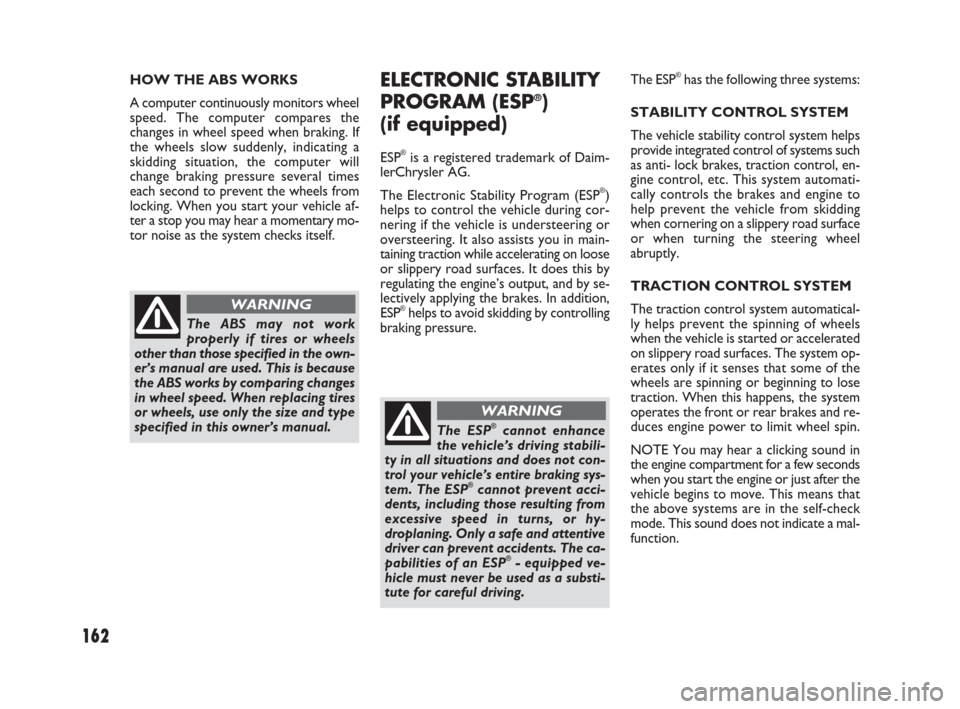
162
HOW THE ABS WORKS
A computer continuously monitors wheel
speed. The computer compares the
changes in wheel speed when braking. If
the wheels slow suddenly, indicating a
skidding situation, the computer will
change braking pressure several times
each second to prevent the wheels from
locking. When you start your vehicle af-
ter a stop you may hear a momentary mo-
tor noise as the system checks itself.
The ABS may not work
properly if tires or wheels
other than those specified in the own-
er’s manual are used. This is because
the ABS works by comparing changes
in wheel speed. When replacing tires
or wheels, use only the size and type
specified in this owner’s manual.
WARNING
ELECTRONIC STABILITY
PROGRAM (ESP®)
(if equipped)
ESP®is a registered trademark of Daim-
lerChrysler AG.
The Electronic Stability Program (ESP
®)
helps to control the vehicle during cor-
nering if the vehicle is understeering or
oversteering. It also assists you in main-
taining traction while accelerating on loose
or slippery road surfaces. It does this by
regulating the engine’s output, and by se-
lectively applying the brakes. In addition,
ESP
®helps to avoid skidding by controlling
braking pressure.
The ESP®cannot enhance
the vehicle’s driving stabili-
ty in all situations and does not con-
trol your vehicle’s entire braking sys-
tem. The ESP
®cannot prevent acci-
dents, including those resulting from
excessive speed in turns, or hy-
droplaning. Only a safe and attentive
driver can prevent accidents. The ca-
pabilities of an ESP
®- equipped ve-
hicle must never be used as a substi-
tute for careful driving.
WARNING
The ESP®has the following three systems:
STABILITY CONTROL SYSTEM
The vehicle stability control system helps
provide integrated control of systems such
as anti- lock brakes, traction control, en-
gine control, etc. This system automati-
cally controls the brakes and engine to
help prevent the vehicle from skidding
when cornering on a slippery road surface
or when turning the steering wheel
abruptly.
TRACTION CONTROL SYSTEM
The traction control system automatical-
ly helps prevent the spinning of wheels
when the vehicle is started or accelerated
on slippery road surfaces. The system op-
erates only if it senses that some of the
wheels are spinning or beginning to lose
traction. When this happens, the system
operates the front or rear brakes and re-
duces engine power to limit wheel spin.
NOTE You may hear a clicking sound in
the engine compartment for a few seconds
when you start the engine or just after the
vehicle begins to move. This means that
the above systems are in the self-check
mode. This sound does not indicate a mal-
function.
149-166 Fiat16 New GB 3-09-2008 8:15 Pagina 162
Page 164 of 266
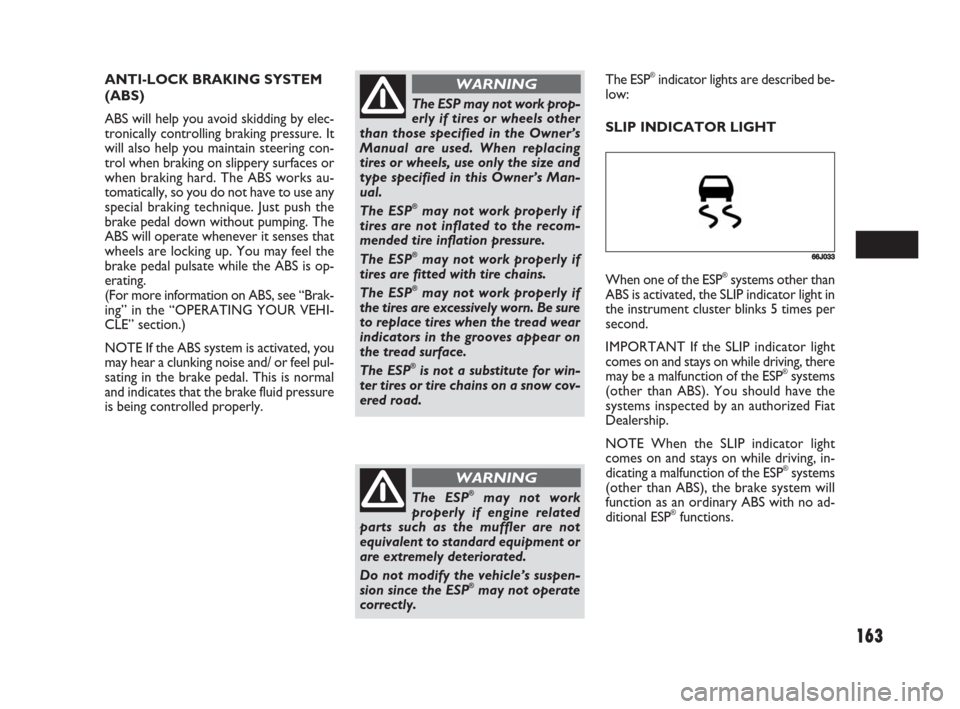
163
The ESP may not work prop-
erly if tires or wheels other
than those specified in the Owner’s
Manual are used. When replacing
tires or wheels, use only the size and
type specified in this Owner’s Man-
ual.
The ESP
®may not work properly if
tires are not inflated to the recom-
mended tire inflation pressure.
The ESP
®may not work properly if
tires are fitted with tire chains.
The ESP
®may not work properly if
the tires are excessively worn. Be sure
to replace tires when the tread wear
indicators in the grooves appear on
the tread surface.
The ESP
®is not a substitute for win-
ter tires or tire chains on a snow cov-
ered road.
WARNING
The ESP®may not work
properly if engine related
parts such as the muffler are not
equivalent to standard equipment or
are extremely deteriorated.
Do not modify the vehicle’s suspen-
sion since the ESP
®may not operate
correctly.
WARNING
ANTI-LOCK BRAKING SYSTEM
(ABS)
ABS will help you avoid skidding by elec-
tronically controlling braking pressure. It
will also help you maintain steering con-
trol when braking on slippery surfaces or
when braking hard. The ABS works au-
tomatically, so you do not have to use any
special braking technique. Just push the
brake pedal down without pumping. The
ABS will operate whenever it senses that
wheels are locking up. You may feel the
brake pedal pulsate while the ABS is op-
erating.
(For more information on ABS, see “Brak-
ing” in the “OPERATING YOUR VEHI-
CLE” section.)
NOTE If the ABS system is activated, you
may hear a clunking noise and/ or feel pul-
sating in the brake pedal. This is normal
and indicates that the brake fluid pressure
is being controlled properly.The ESP®indicator lights are described be-
low:
SLIP INDICATOR LIGHT
66J033
When one of the ESP®systems other than
ABS is activated, the SLIP indicator light in
the instrument cluster blinks 5 times per
second.
IMPORTANT If the SLIP indicator light
comes on and stays on while driving, there
may be a malfunction of the ESP
®systems
(other than ABS). You should have the
systems inspected by an authorized Fiat
Dealership.
NOTE When the SLIP indicator light
comes on and stays on while driving, in-
dicating a malfunction of the ESP
®systems
(other than ABS), the brake system will
function as an ordinary ABS with no ad-
ditional ESP
®functions.
149-166 Fiat16 New GB 3-09-2008 8:15 Pagina 163
Page 165 of 266
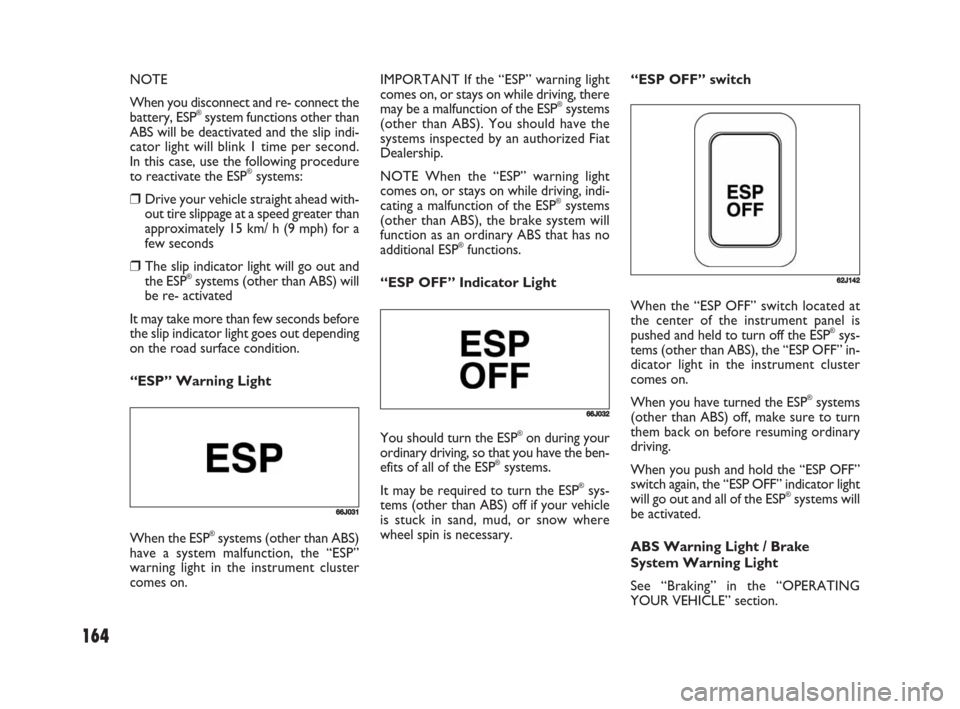
164
NOTE
When you disconnect and re- connect the
battery, ESP
®system functions other than
ABS will be deactivated and the slip indi-
cator light will blink 1 time per second.
In this case, use the following procedure
to reactivate the ESP
®systems:
❒Drive your vehicle straight ahead with-
out tire slippage at a speed greater than
approximately 15 km/ h (9 mph) for a
few seconds
❒The slip indicator light will go out and
the ESP®systems (other than ABS) will
be re- activated
It may take more than few seconds before
the slip indicator light goes out depending
on the road surface condition.
“ESP” Warning LightIMPORTANT If the “ESP” warning light
comes on, or stays on while driving, there
may be a malfunction of the ESP
®systems
(other than ABS). You should have the
systems inspected by an authorized Fiat
Dealership.
NOTE When the “ESP” warning light
comes on, or stays on while driving, indi-
cating a malfunction of the ESP
®systems
(other than ABS), the brake system will
function as an ordinary ABS that has no
additional ESP
®functions.
“ESP OFF” Indicator Light“ESP OFF” switch
When the “ESP OFF” switch located at
the center of the instrument panel is
pushed and held to turn off the ESP
®sys-
tems (other than ABS), the “ESP OFF” in-
dicator light in the instrument cluster
comes on.
When you have turned the ESP
®systems
(other than ABS) off, make sure to turn
them back on before resuming ordinary
driving.
When you push and hold the “ESP OFF”
switch again, the “ESP OFF” indicator light
will go out and all of the ESP
®systems will
be activated.
ABS Warning Light / Brake
System Warning Light
See “Braking” in the “OPERATING
YOUR VEHICLE” section.66J031
When the ESP®systems (other than ABS)
have a system malfunction, the “ESP”
warning light in the instrument cluster
comes on.
66J032
You should turn the ESP®on during your
ordinary driving, so that you have the ben-
efits of all of the ESP
®systems.
It may be required to turn the ESP
®sys-
tems (other than ABS) off if your vehicle
is stuck in sand, mud, or snow where
wheel spin is necessary.
62J142
149-166 Fiat16 New GB 3-09-2008 8:15 Pagina 164
Page 170 of 266
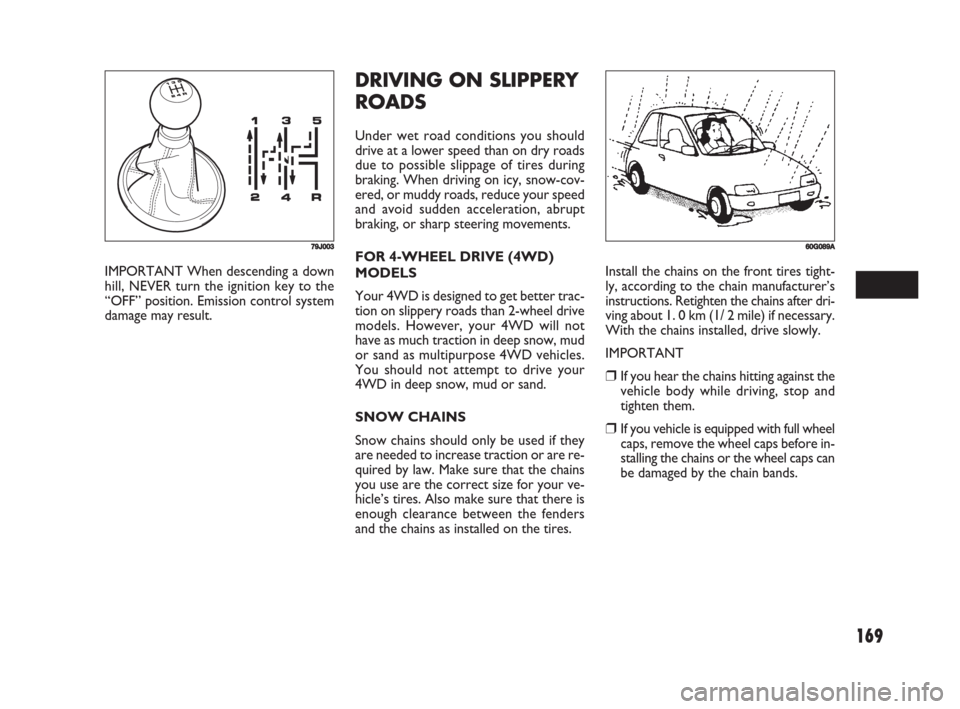
169
DRIVING ON SLIPPERY
ROADS
Under wet road conditions you should
drive at a lower speed than on dry roads
due to possible slippage of tires during
braking. When driving on icy, snow-cov-
ered, or muddy roads, reduce your speed
and avoid sudden acceleration, abrupt
braking, or sharp steering movements.
FOR 4-WHEEL DRIVE (4WD)
MODELS
Your 4WD is designed to get better trac-
tion on slippery roads than 2-wheel drive
models. However, your 4WD will not
have as much traction in deep snow, mud
or sand as multipurpose 4WD vehicles.
You should not attempt to drive your
4WD in deep snow, mud or sand.
SNOW CHAINS
Snow chains should only be used if they
are needed to increase traction or are re-
quired by law. Make sure that the chains
you use are the correct size for your ve-
hicle’s tires. Also make sure that there is
enough clearance between the fenders
and the chains as installed on the tires.Install the chains on the front tires tight-
ly, according to the chain manufacturer’s
instructions. Retighten the chains after dri-
ving about 1. 0 km (1/ 2 mile) if necessary.
With the chains installed, drive slowly.
IMPORTANT
❒If you hear the chains hitting against the
vehicle body while driving, stop and
tighten them.
❒If you vehicle is equipped with full wheel
caps, remove the wheel caps before in-
stalling the chains or the wheel caps can
be damaged by the chain bands. IMPORTANT When descending a down
hill, NEVER turn the ignition key to the
“OFF” position. Emission control system
damage may result.
79J00360G089A
167-170 Fiat16 New GB 3-09-2008 8:15 Pagina 169
Page 171 of 266
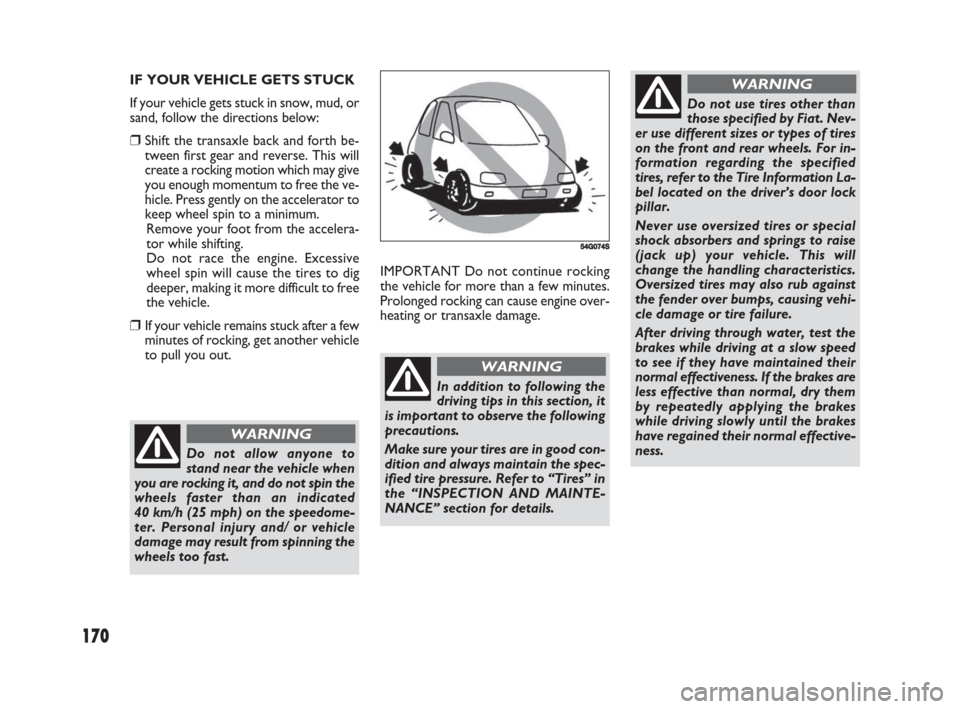
170
IMPORTANT Do not continue rocking
the vehicle for more than a few minutes.
Prolonged rocking can cause engine over-
heating or transaxle damage. IF YOUR VEHICLE GETS STUCK
If your vehicle gets stuck in snow, mud, or
sand, follow the directions below:
❒Shift the transaxle back and forth be-
tween first gear and reverse. This will
create a rocking motion which may give
you enough momentum to free the ve-
hicle. Press gently on the accelerator to
keep wheel spin to a minimum.
Remove your foot from the accelera-
tor while shifting.
Do not race the engine. Excessive
wheel spin will cause the tires to dig
deeper, making it more difficult to free
the vehicle.
❒If your vehicle remains stuck after a few
minutes of rocking, get another vehicle
to pull you out.
Do not allow anyone to
stand near the vehicle when
you are rocking it, and do not spin the
wheels faster than an indicated
40 km/h (25 mph) on the speedome-
ter. Personal injury and/ or vehicle
damage may result from spinning the
wheels too fast.
WARNING
54G074S
In addition to following the
driving tips in this section, it
is important to observe the following
precautions.
Make sure your tires are in good con-
dition and always maintain the spec-
ified tire pressure. Refer to “Tires” in
the “INSPECTION AND MAINTE-
NANCE” section for details.
WARNING
Do not use tires other than
those specified by Fiat. Nev-
er use different sizes or types of tires
on the front and rear wheels. For in-
formation regarding the specified
tires, refer to the Tire Information La-
bel located on the driver’s door lock
pillar.
Never use oversized tires or special
shock absorbers and springs to raise
(jack up) your vehicle. This will
change the handling characteristics.
Oversized tires may also rub against
the fender over bumps, causing vehi-
cle damage or tire failure.
After driving through water, test the
brakes while driving at a slow speed
to see if they have maintained their
normal effectiveness. If the brakes are
less effective than normal, dry them
by repeatedly applying the brakes
while driving slowly until the brakes
have regained their normal effective-
ness.
WARNING
167-170 Fiat16 New GB 3-09-2008 8:15 Pagina 170